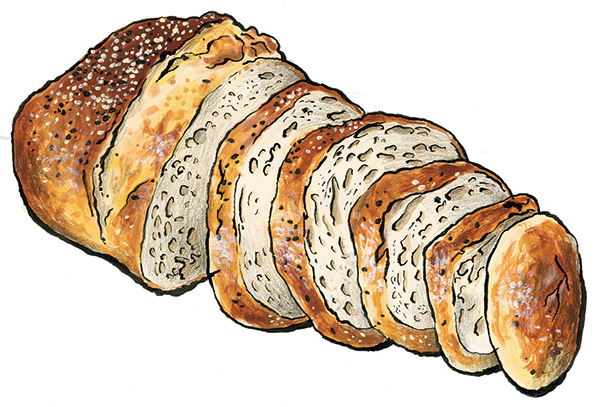The secret ingredient for our bread is time. Letting bread dough ferment for longer before we bake it allows it to develop much deeper flavors. Our cinnamon raisin bread takes about fifteen hours to produce. French Mountain Bread takes a whopping eighteen hours. But when you take ingredients into consideration, our Parmesan Pepper Bread takes the cake. We measure its time not in hours, but years.
Let’s start with the cheese.
Real Parmigiano Reggiano (AKA parmesan) is made only in a handful of provinces in northern Italy. At each of the 600 small dairies that produce parmesan, the cheesemaking is overseen by an expert called a casaro . Becoming a casaro requires ten to fourteen years of apprenticeship–which, as Ari Weinzweig notes in the Guide to Good Eating , is as much time as we take to train a brain surgeon here in the US.
The casaro only oversees the first few days of production, from when the milk is brought to the dairy until the new, baby wheels of parmesan are ready to be sent to huge aging rooms to mature. Each wheel must then age for at least two summers. The summer is important because the cheese ages at ambient temperatures, and the summer heat intensifies the natural bacterial activity in the cheese that creates much of the flavor. By the time it’s ready to sell, each wheel of cheese is at least eighteen months old—it takes that long to develop the deep, sweet, nutty flavors we associate with a good hunk of parm. Some wheels age even longer; to get through two summers, a wheel that was created in the fall will be closer to 24 months old before it’s ready to sell.
Producing pepper isn’t quick, either.
Black pepper grows on a vine only in the tropics where it can get a lot of heat and a long rainy season. After planting a new vine, it takes two to five years for that plant to produce fruit. The peppercorn we know is the seed of a berry. Each spring, pollinated pepper flowers will produce a short, spiky stem that holds 50-100 small berries. When they’re ripe, the berries are picked, dried for a few days, and then cured for about nine months.
Our parmesan pepper bread uses Tellicherry peppercorns. The Tellicherry variety is known for being more aromatic than other peppers, and for being some of the largest peppercorns you can find. The aroma and the size are both due to the fact that Tellicherry peppercorns are more mature when they’re harvested—they get a few more days or weeks to ripen and develop flavor than other, smaller peppercorns.
The ingredients take a couple of years. Then there’s the bread.
To make Parmesan Pepper bread, the bakers start with whole wheels of parmesan. Each wheel is cracked open by hand using the traditional method: the outside of the wheel is scored all the way around, and then three special knives are wedged into the wheel and used to carefully split the wheel into two halves. Likewise, they start with whole Tellicherry peppercorns, not boxes of pre-ground powder, which they crack into irregular bits just before baking.
The sourdough starter we use for our Farm bread—the same starter they’ve been using since the Bakehouse started baking bread more than twenty years ago—is the base. Some of that starter ferments for eight hours, and then they mix in flour, water, salt, and the good stuff: a quarter pound of parmesan per loaf and plenty of freshly cracked pepper. Once everything’s kneaded together the dough ferments for another three hours. The bakers shape the dough into individual loaves, and then it’s three more hours of fermentation. Finally, the bread is sprinkled with a dusting of pepper and then it’s into the oven for 40 minutes. All told, it’s a sixteen hour process to produce a loaf of Parmesan Pepper bread. Add in the two years to produce the parmesan and the pepper and we’re talking 17,536 hours per loaf.
But wait! There’s one more step.
For just about all of our breads, we recommend double baking—that is, popping the loaf in the oven to heat it up again before you eat it. It’s a powerful process, reviving a few-days-old loaf to that “fresh baked” status. But when you double bake a loaf of Parmesan Pepper bread, it’s almost magical. As it warms, it fills the kitchen with the rich aroma of melting cheese and spicy black pepper. When it’s ready, it’s nearly a meal on its own.
1. Take the bread out of the bag
2. Preheat your oven to 350 degrees
3. Throw half, whole, or part of the loaf on the oven rack naked
4. Leave it there until it’s hot in the center, about 20 minutes for whole loaves of 10 minutes for partial loaves
5. Take time to smell the roses, or, better yet, the sensual aroma coming out of your oven
6. Take the loaf out of the oven and let it rest for a few minutes (it’s hot!)
7. Tear huge chunks out of it and eat alongside a bottle of one of those new, dry Lambruscos from Emilia Romagna that are making their way to America now

